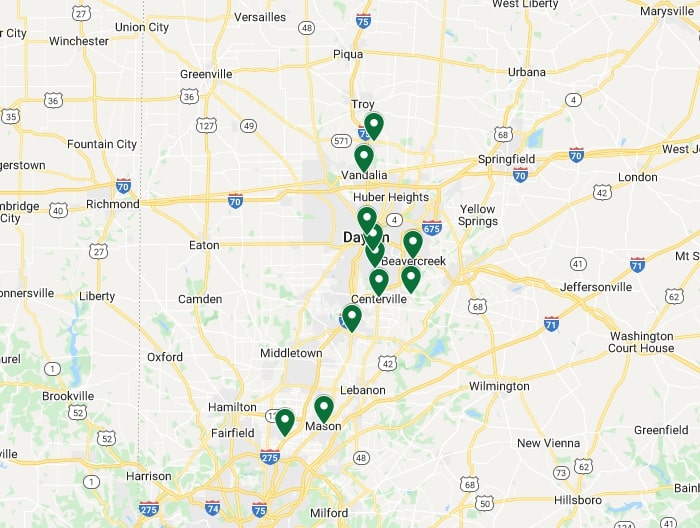 For a lovely, green and weed-free lawn, you need to provide Turf Care.
For a lovely, green and weed-free lawn, you need to provide Turf Care.
A healthy lawn needs fertilizer and weed control at the proper intervals. It requires ample water and aeration annually to relieve compaction and provide air. Lastly, it should be mowed regularly at the proper height with sharp blades for a clean cut.
Sounds easy, right? All your lawn needs is food, water, air, preventative medicine and a regular hair cut. The catch is it needs the right kind of food and preventative medicine at the right time of year to keep it healthy.
Let’s learn a little about the grass itself. In Ohio, the primary varieties of turf grasses include – Kentucky Bluegrass, Perennial Ryegrass, Fine Fescue and Tall Fescue. Here are some considerations for each type –
Kentucky Bluegrass
A deep green grass with a velvety fine texture.
- Spreads & heals damaged areas without reseeding.
- Performs best in full sun.
- Tolerant to both cold and drought.
- Newer varieties have a higher resistance to disease.
Perennial Ryegrass
A bright green fast growing fine texture grass.
- Quick germination period.
- Good drought tolerance.
- High wear tolerance
- High insect and disease resistance.
Fine Fescues
The finest leaves that stay green all year.
- Good drought tolerance
- High shade tolerance
- Low moisture requirements
- Varieties include Creeping Red, Hard and Chewings
Tall Fescue
A flexible and durable rich green grass.
- Heat tolerant.
- Drought tolerant.
- High wear tolerance.
- Disease resistant.
These Cool Season grasses grow best in the spring and fall. While they may show signs of heat stress in the summer, they will remain green throughout most of the winter season. So what do these grasses need to perform at their best?
- Fertilization feeds the grass making it strong, green and healthy. These feedings should be formulated for your soil conditions in either liquid or granular form and applied throughout the year.
- Weed Control needs to begin early in the season and it requires ongoing attention all year long. Temperature, stage of growth and humidity can all impact the effectiveness of weed control.
- Crabgrass Control requires both pre-emergent and post-emergent care. Again treatment must begin early before germination occurs.
- Disease Control is a remedy for damage that has occurred and promotes recovery.
- Mowing at the right time and right height with sharp blades.
- Core Aeration reduces soil compaction and allows air to reach the grass roots so water and fertilizer can be taken up by the plant. The loosened soil allows the grass roots to spread for deeper root penetration and healthier lawn.
- Overseeding introduces new grass seed that thickens the existing turf and fill-ins thin areas. In conjunction with core aeration, germination is enhanced since the holes provide a protective place for the seeds. As the new grass grows, weeds will be reduced since the space is no longer desirable for their purposes.
If you had a lovely lawn and for some reason – it changed? Your lawn may need a course of treatment to restore its beauty. We call that turf renovation. The first step is to accurately diagnose the problem. For example, drought, excessive shade, tree root competition, poor drainage, soil compaction, inadequate fertilizer, acid soils, weed or insect infestation, lawn disease, and other things may be contributing to the issue. Most of these problems are correctable with renovation and improved maintenance practices. If you think your lawn may need renovation – please contact us so we can help you develop a plan to cure your ailing lawn.
Lastly, if you have a new home and need to establish a new lawn? You can either seed or sod it. Regardless of your choice, soil preparation is important. A soil test should be taken so, the necessary amendments can be prepared and added to the soil. The area should be graded and if needed, an initial application of herbicide should be used to kill off existing weeds before the seed or sod are applied. Here are some considerations for both approaches –
Seeding
- A larger selection of species are available for varying management practices such as, sun versus shade, disease resistance and soil type.
- The grass will grow in the environment where it will live.
- Lower initial cost than sodding.
- Timing is critical – it’s best to seed in the fall. Early spring is a possibility also but weed seeds germinate in the spring as well.
- Watering is critical.
- It will take longer to achieve a dense lawn.
Sodding
- Instant Lawn and basically weed free.
- May be walked on shortly after planting.
- Dust, mud and erosion are reduced quickly.
- Can be planted anytime during the growing season with adequate watering.
- Higher initial cost.
- Limited species of grass available.
- Large volume of water will be needed initially.
- Speed of rooting time varies with season. Spring and fall are best.
If you have any questions about the information provided here – please do not hesitate to contact us.
The lawn of your dreams is possible. For professional assistance with your turf care needs – contact us today at 937.433.5915.
Kris McKee
Owner
Country Club Landscaping
To learn more check out this link – National Association of Landscape Professionals



